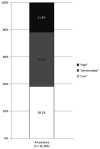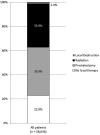Current clinical presentation and treatment of localized prostate cancer in the United States
- PMID: 24931803
- PMCID: PMC10988984
- DOI: 10.1016/j.juro.2014.06.017
Current clinical presentation and treatment of localized prostate cancer in the United States
Abstract
Purpose: SEER recently released patient Gleason scores at biopsy/transurethral resection of the prostate. For the first time this permits accurate assessment of prostate cancer presentation and treatment according to clinical factors at diagnosis.
Materials and methods: We used the SEER database to identify men diagnosed with localized prostate cancer in 2010 who were assigned NCCN(®) risk based on clinical factors. We identified sociodemographic factors associated with high risk disease and analyzed the impact of these factors along with NCCN risk on local treatment.
Results: Of the 42,403 men identified disease was high, intermediate and low risk in 38%, 40% and 22%, respectively. On multivariate analysis patients who were older, nonwhite, unmarried or living in a county with a higher poverty rate were more likely to be diagnosed with high risk disease (each p <0.05). Of the 38,634 men in whom prostate cancer was the first malignancy 23% underwent no local treatment, 40% were treated with prostatectomy, 36% received radiation therapy and 1% underwent local tumor destruction, predominantly cryotherapy. On multivariate analysis patients who were older, black, unmarried or living in a county with a higher poverty rate, or who had low risk disease were less likely to receive local treatment (each p <0.05).
Conclusions: Our analysis provides information on the current clinical presentation and treatment of localized prostate cancer in the United States. Nonwhite and older men living in a county with a higher poverty rate were more likely to be diagnosed with high risk disease and less likely to receive local treatment.
Keywords: healthcare disparities; neoplasm grading; prostate; prostatic neoplasms; risk.
Copyright © 2014 American Urological Association Education and Research, Inc. Published by Elsevier Inc. All rights reserved.
Figures







References
-
- Siegel R, Naishadham D, Jemal A. Cancer statistics, 2013. CA Cancer J Clin. 2013;63:11. - PubMed
-
- Surveillance, Epidemiology, and End Results (SEER): About SEER. National Cancer Institute. [accessed 08/01/2013]. http://www.seer.cancer.gov/about .
-
- Elliott SP, Johnson DP, Jarosek SL, et al. Bias due to missing SEER data in D’Amico risk stratification of prostate cancer. J Urol. 2012;187:2026–2031. - PubMed
MeSH terms
Grants and funding
LinkOut - more resources
Full Text Sources
Other Literature Sources
Medical

